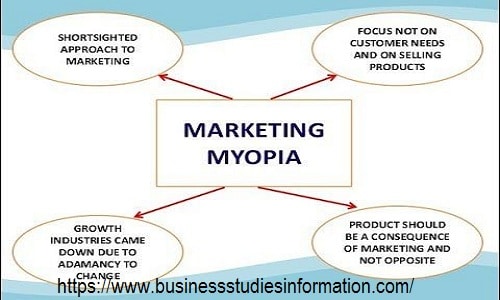Marketing is referred to as the activities which a company offers to increase the buying or selling of a product, goods, or services. Then in achieving your goals or improving sales, you have to take into consideration the needs of your customers instead of just trying to increase sales. Your aim in marketing should be on how to solve the problems of your customers. Therefore, this article torchlights what marketing myopia entails, its definitions, examples, and how to avoid marketing myopia.
Marketing Myopia Definition
A concise definition of marketing myopia is a situation where market technique and concentration depend primarily on a single element (product) than on the needs of the buyers
The world is growing fast with more technological advancement, Therefore It is time to recognize the age we live in by lifting a shift from the supply chain to the demand chain.
Hence, if you want to avoid marketing myopia, all you’ve got to do is to define organizational goals towards achieving the needs of your buyers.
What Is Marketing Myopia?
Marketing myopia comes in when short-term marketing goals are given more significance than long-term goals. It is also a situation when a company has a conventional marketing approach and it focuses mainly on only one aspect out of many possible marketing attributes. What this simply means is that the company has placed more focus on its products without taking into consideration its buyer’s really needs.

Have in mind that what is appealing to you might not be appealing to your customers. Therefore study your market to avoid marketing myopia.
Read Also: SOCIAL MARKETING: The Basic Guide With Practical Examples
Causes of Marketing Myopia
However, there are many causes of marketing myopia. It varies from company to company. Below are some of the common causes of the poor marketing strategy.
#1. Overconfidence
The major cause of failure is not considering the requirement of customers as a part of your marketing strategy. Most companies are so overconfident that they stop asking their customers what they prefer or want. This eventually leads to creating a big gap between the company and its buyer. As a result, whenever a contender enters the market with what is appealing to them, they do nothing other than leave the marketing myopic brand immediately.
#2. Overlooking the Market Demand
Market myopic companies focus only on their product, not the needs and requirements of customers. They are concerned with the production, overlooking the market demands. As a result, customers only patronize their product if there is no other brand.
Although some companies feel they have been in existence for decades and thus, leading the market. So, they believe that using their sale strategies, whatever they produce will sell.
This deceiving marketing myopia belief makes them lazy. They feel relaxed by not digging deep into research and development to keep growing. In the end, a competitor takes over the market with unique features and appeals.
#3. Failure to Update Products and Services
As technology evolves, products, services, and lifestyles change. Therefore, if marketers don’t keep in mind the changing lifestyle of customers then, their product becomes out-of-date. No customer will buy any product that doesn’t meet the trending demands.
Examples Of Marketing Myopia
Having learned marketing myopia. I believe you would not want to fall, victim. Here are some examples of marketing myopia.
- Kodak lost much of its share to Sony cameras when digital cameras boomed and Kodak didn’t plan for it.
- Nokia loses its marketing share to android and IOS.
- Blackberry’s phones had about 50% market share in the US and also about 20% worldwide in 2006. When Smartphones were introduced into the market, blackberry’s market started sinking. However, the smartphone industry has taken the space and blackberry holds 0% of the market the smartphone.
- Another marketing myopia example is Yahoo losing about $150 billion in 2000 to Google and was bought by Verizon at approx. $6 billion (2016).
What Causes Marketing Myopia?
One of the leading causes of marketing myopia is failing to take into account what consumers need and want from a company’s product or service. Your company will develop marketing myopia if you ignore customer suggestions, requests, and feedback and do nothing to improve your products or services as a result.
What Are the Two Main Causes of Myopia?
Eyes that are too long or oval-shaped, rather than round, are typically the cause of nearsightedness. Too much of a slant in the cornea can also cause this problem. Because of these adjustments, light rays converge at a point in front of the retina and then cross.
How to Avoid Marketing Myopia
Consider the following recommendations when you develop your marketing tactics to focus on the future and long-term growth:
#1. Establish long-term objectives.
Long-term goal planning can assist businesses in developing efficient marketing strategies. As a marketing professional, keeping track of both long-term and short-term goals is beneficial. You may, for example, define objectives for new items. This might assist you in tracking the effectiveness of various marketing techniques.
You may help your firm flourish by combining short-term and long-term objectives. For example, in addition to a short-term product target, you may set a longer-term customer goal, such as gaining 100,000 new customers in the following five years. Concentrating on acquiring new consumers can help you create new revenue for a longer period of time.
#2. Incorporate the customer into your plan.
When planning a great marketing strategy, keep the client in mind. When developing products and marketing techniques, try to consider the customer’s point of view. You could also solicit client feedback. When businesses prioritize client connections and satisfaction, they can achieve more effective long-term growth.
#3. Carry out considerable research
Conducting extensive market research will help you avoid marketing myopia. Before launching new items, conduct market research to identify your target audience. This might assist you in refining and improving the product before its release. Consider conducting research after the product introduction as well. Markets and audiences might shift over time, therefore it’s important to undertake research on a regular and frequent basis to spot any shifts.
#4. Maintain your product marketing efforts.
Long-term growth companies continue to sell their existing items. You can assist develop your audience and expanding your business by continuing to sell things. You can also boost your brand’s reputation by reminding customers about your goods. You and your marketing team can go over the campaign and make modifications as needed.
#5. Provide your customers with a number of options.
Consider offering your customers a diversity of products and services to avoid myopia. For example, if your company offers t-shirts, you can consider expanding your product line to include trousers or shoes. This can help you attract new customers while also encouraging existing customers to purchase more things.
You may also increase your audience by including variety in your marketing effort. If your firm predominantly uses social media, for example, you can include a television commercial to attract clients who may not use social media. You can help your company grow by adding additional clients.
#6. Experiment with fresh techniques
Experimenting with new techniques is a key aspect of long-term success. As the market evolves, you may be required to create new items or marketing strategies. Consider putting innovative tactics to the test in the market. For example, you could do a modest product launch with a small group of people to test a new marketing strategy.
#7. Examine and improve
Make time to analyze and improve your company’s marketing strategies and goals. This varies based on your industry and the size of your company. You can do this once a year or once a quarter. You can schedule a regular time to review your goals and set new ones. Look for areas for improvement and focus on long-term growth.
#8. Keep up with market developments.
Customers’ desires may alter as the market changes. Customers, for example, may desire extra services from businesses as technology evolves. Consider subscribing to marketing news or undertaking frequent market research to stay up to date on these trends. You may build marketing strategies and goods that fit your clients’ requirements and demands by knowing about trends and changes.
What Activities Cause Myopia?
The time children spend reading and doing other near work has long been suspected as a possible cause of myopia development because of the high visual demands of such activities and the prevalence of myopia during the school years.
Who Overcome Marketing Myopia?
The Apple Corporation is a prime example of a successful business that has, throughout its history, been able to avoid the pitfalls of marketing myopia. One of the most successful computer manufacturers, Apple, was founded in a garage.
Read Also: Mistakes you Should Avoid as a Start-up Entrepreneur
Future Marketing Myopia
- Cleaning services – New fibers and chemicals will reduce the requirement for dry cleaners.
- Supermarkets – Grocery businesses will become obsolete as people adopt a more digital lifestyle.
- Facebook: As a result of the new GDPR and data privacy requirements, Facebook will either need to adjust its business model or risk losing social media market share to other data-privacy-focused social media companies.
Summary
The main idea of marketing myopia is meeting customers’ needs. When you focus on your products rather than your customers’ needs, you will definitely lose your prospective customers.
In business, you can agree with me that, customers influence customers. They promote your market irrespective of the strategy involved. If your products meet their demands, they automatically approve and refer your product to others. It’s important to take action by preventing it from affecting your business growth.
Marketing Myopia FAQs
What is myopia strategy?
Strategic myopia is a condition in which a company’s management can see clearly what is going to happen in the short term but has only a hazy idea of what their future might be in the long run.
What is green marketing myopia?
The marketing approach involves an effort to increase the environmental quality of its product or service but fails to achieve customer happiness, resulting in an imbalance between the company’s marketing goals.
Is marketing myopia relevant today?
Because the original concept is not prescriptive, marketing myopia has never been more relevant than today. Rather than providing a how-to guide for overcoming marketing myopia, Levitt aimed to provoke individuals to think differently and influence how business students were taught about marketing.
Related Articles:
- What Is BUSINESS CYCLE?- Definition, Internal and External Causes
- Procuring Cause: Definition, Guidelines, And US Guidelines
- 6 RCA Tools You Will Learn About in RCA Training
- CYCLICAL UNEMPLOYMENT: Definition, Examples, Rates & Causes.
- Target Marketing: All you need to know
- Voluntary AD&D: What is Voluntary AD&D? Pros & Cons (+ Free tips)






